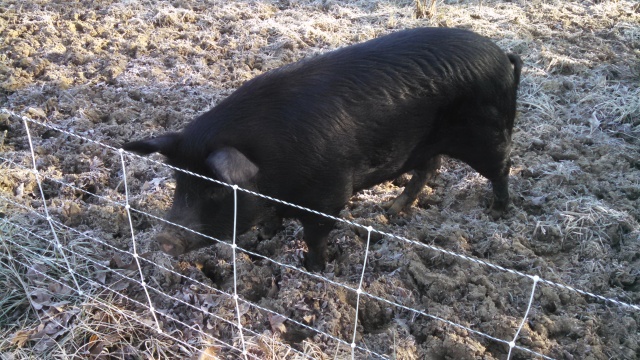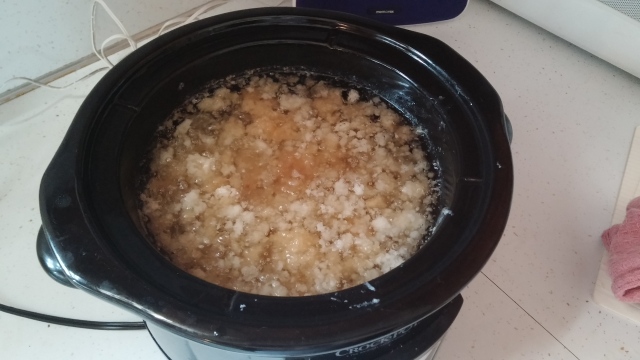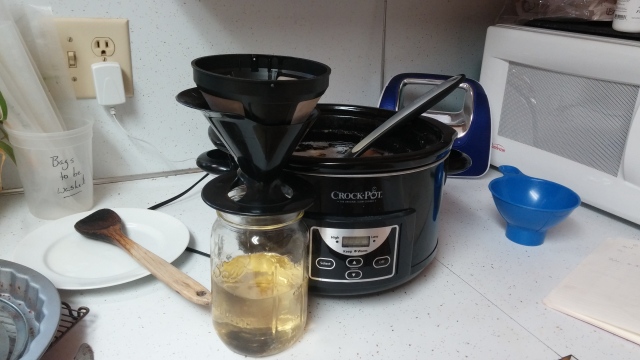You know, after two pig roasts and a handful of home butchering experiences, I’m compiling a ridiculous number of recipes that begin “start with a whole pig.” These are, perhaps, difficult to recreate at home for the average reader.
However, I’m going to share one of them with you today: Home Rendered Lard.
I know, the very word might set you off a bit, given its bad press since WW2, when lard’s place in the American diet was taken over by a highly processed upstart. However, back before the days of factory farming and ridiculous hydrogenated fat (WHY do people still think that margarine is a health food, WHY?), lard was a regular dietary staple, and the best choice for many recipes. Sure, it’s fat, but it’s “significantly lower in both saturated fat AND cholesterol than butter,” according to many many sources, including the King Arthur flour site linked to that quote.
Now, I’m not arguing that lard is health food, despite the hyperbole flung about by the paleo crowd, but if you’re going to be baking, you’re going to be using fat. Why not use the best fat available? Lard from sustainably-raised animals is not only better for you, it’s totally delicious, and perfect for amazing results with pastry and biscuits (I also chuck a little in my Sourdough Bread). A few weeks ago, I even made a batch of chocolate chip cookies with half lard/half butter, and they were delicious.
But Fae, you might say, I don’t HAVE a pig. That’s likely true, but I bet you have access to fatback or leaf lard. Try sustainable meat producers at your local farmer’s market, a good butcher, Whole Paycheck, or if you’re in North Carolina like me, pop by Yellow Wolf Farm, where we get our pigs. Stacy’s open most Saturdays and sells in a few local markets as well. What you DON’T want to do is buy that shelf-stable lard at the grocery. Not only is it made from factory farmed pigs, most of it is hydrogenated to make it shelf stable. So you’re basically buying pig margarine. Yuck.
Once you have your fat, it’s a simple, hands-off project to render it into beautiful white cooking fat, with the help of your trusty crockpot.
Crockpot Lard
Equipment:
A meat grinder or sharp knife, a crockpot, something to strain the melted lard with, and jars to store it in.
Ingredients:
Pig fat, any amountAbout a half cup of water
Method:
If you’re using a meat grinder, which for me is an attachment on my kitchenaid, cut the lard into long strips about a half inch wide. This is totally the best tip I picked up at the amazing Sausage Making Workshop I did for my birthday last year: the long strips get caught by the screw and are pulled through the grinder all on their own. No mashing about trying to get little cubes to go down the feed tube.
No meat grinder? No problem. Just cut it into small dice. The nice thing about small pieces is that it melts faster, but it will all get there nonetheless.
After you’ve ground or cut it all, add a half cup of water, turn your crockpot on to low, and cook it for about 2 hours uncovered (so the water cooks out) and 8 hours covered, for a total of around 10 hours. That’s it! The lard will slowly render out of the fat, until you’ve got a crock full of clear melted beauty, with a raft of crispy brown bits on top. Those are the famed cracklings that people put in cornbread, or snacked on. You can salt and eat that debris (it’s delicious), but we generally give it to the chickens, which makes them very happy. Plus, we enjoy turning leftovers from pig fat into chicken. Recyclers, that’s what we are.
When it’s all melted, you’ll need to strain it. Many folks recommend cheesecloth for this step, but I actually use a Melita coffee filter holder which magically fits right on top of a wide mouth quart mason jar. You can line it with paper filters, but I use a reusable filter as well, which has nice fine mesh (one of these).
Clearly I don’t get super tidy for these pictures. Once it’s cool, tuck the jars into the fridge. They will basically last forever, refridgerated… but I promise, the first time you fry some chicken or bake a pie crust, you’ll be a lard convert, and those jars will shrink away in no time.
Here at the Farmlet, I’ve been saying for months now “Lard is free, butter costs money”. And after tasting my own home-rendered lard, I feel WAY less sorry for all those kids in stories that ‘only had lard to scrape across their bread.’
Lard is delicious. You should try it. Next time, I’ll follow up with a great lard pie crust recipe, the one we used to make all those pies for the event last weekend.
Until next time,
~Fae
This post shared on Homestead Blog Hop #25. Thanks for visiting!







How do they make lard shelf stable? My mom used lard to fry her doughnuts in. They were the best.
LikeLiked by 1 person
All I know is that it’s hydrogenated, which makes it much harder at room temp. There’s a bit more information here: http://www.wisegeek.org/what-is-lard.htm
LikeLike
I wanted to try making lard last time we had a pig butchered. But the butcher forgot to save us the fat from it. I’ve never seen instructions using a crock pot to render it in, that makes it look even easier to do yet! I’m going to keep this in mind for the next time we butcher a pig.
LikeLiked by 1 person
That’s one of the reasons we home butchered… We wanted every scrap, and had heard sometimes you don’t get everything from the processor.
LikeLike
you give the cracklins to the chickens??! happy chix….sad cracklin in cornbread lovin kentuckian over here….lol
good tip on the crock pot! ive only seen lard rendered outside…either over a kettle on a fire, or in grandmas “summer kitchen” outside on her porch which had a snapper over propane that my uncle got her.
LikeLiked by 1 person
You know, I don’t like to cook it long enough for the cracklings to get crispy…the chickens don’t mind if they’re pallid and underdone.
LikeLike
you’ve ruined me on crisco. time to make my own lard.
LikeLiked by 1 person
Well then, my work here is done!
LikeLike
Pingback: Bringin’ home the bacon. Literally. | Species Confusion
Pingback: For luck in the New Year (Black-eyed Peas and Collards) | Species Confusion